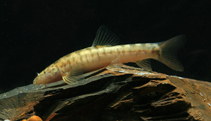Upload your photos and videos
Pictures | Google imageSchistura jarutanini
Picture by Panitvong, N.
Pictures | Google imageSchistura jarutanini
Picture by Panitvong, N.
Classification / Names Nombres comunes | Sinónimos | Catalog of Fishes(Género, Especie) | ITIS | CoL | WoRMS | Cloffa
> Cypriniformes (Carps) > Nemacheilidae (Brook loaches)
Etymology: Schistura: Greek, schizein = to divide + Greek, oura = tail; an allusion to forked caudal fins (Ref. 45335); jarutanini: Named for Mr. Kitipong Jarutanin, who collected various new fish species in Thailand (Ref. 37830).
Eponymy: Khun Jarutanin Kittipong (d: 1958) is a Thai aquarium fish dealer in Bangkok. [...] (Ref. 128868), visit book page.
More on author: Kottelat.
Etymology: Schistura: Greek, schizein = to divide + Greek, oura = tail; an allusion to forked caudal fins (Ref. 45335); jarutanini: Named for Mr. Kitipong Jarutanin, who collected various new fish species in Thailand (Ref. 37830).
Eponymy: Khun Jarutanin Kittipong (d: 1958) is a Thai aquarium fish dealer in Bangkok. [...] (Ref. 128868), visit book page.
More on author: Kottelat.
Environment: milieu / climate zone / depth range / distribution range Ecología
; agua dulce demersal. Tropical
Distribución Países | Áreas FAO | Ecosistemas | Ocurrencias, apariciones | Point map | Introducciones | Faunafri
Asia: Amphoe Sri Sawat, Tham Ba Dan in the Mae Nam Kwae Yai basin in western Thailand.
Tamaño / Peso / Age
Short description Claves de identificación | Morfología | Morfometría
Radios blandos dorsales (total) : 12; Radios blandos anales: 8. Eye reduced to absent.
A troglobitic species, strictly living in cave stream. Feeds on benthic microorganisms (Ref. 58784). Known only from the 22 specimens comprising the type series. Eyes reduced or absent. Well pigmented.
Life cycle and mating behavior Madurez | Reproducción | Puesta | Huevos | Fecundidad | Larva
Main reference
Upload your references | Referencias | Coordinador | Colaboradores
Proudlove, G.S., 1997. A synopsis of the hypogean fishes of the world. p. 351-354. In Proceedings of the 12th International Congress of Speleology, La Chaux de Fonds, Switzerland. vol. 3. (Ref. 27297)
IUCN Red List Status (Ref. 130435: Version 2024-2)
Vulnerable, ver lista roja de la UICN (VU) (D2); Date assessed: 25 February 2011
CITES
Not Evaluated
Threat to humans
Harmless
Human uses
Pesquerías: sin interés
FAO - Publication: search | FishSource |
Más información
Trophic ecology
componentes alimenticios
Composición de la dieta
consumo de alimento
Food rations
Despredadores
componentes alimenticios
Composición de la dieta
consumo de alimento
Food rations
Despredadores
Population dynamics
Coeficiente del crecimiento para
Max. ages / sizes
Length-weight rel.
Length-length rel.
Length-frequencies
Mass conversion
Reclutamiento
Abundancia
Coeficiente del crecimiento para
Max. ages / sizes
Length-weight rel.
Length-length rel.
Length-frequencies
Mass conversion
Reclutamiento
Abundancia
Life cycle
Reproducción
Madurez
Maturity/Gills rel.
Fecundidad
Puesta
Spawning aggregations
Huevos
Egg development
Larva
Dinámica larvaria
Reproducción
Madurez
Maturity/Gills rel.
Fecundidad
Puesta
Spawning aggregations
Huevos
Egg development
Larva
Dinámica larvaria
Anatomy
Superficie branquial
Brain
Otolith
Superficie branquial
Brain
Otolith
Physiology
Body composition
Nutrients
Consumo del oxígeno
Tipo de natación
Velocidad de natación
Visual pigments
Fish sound
Diseases & Parasites
Toxicity (LC50s)
Body composition
Nutrients
Consumo del oxígeno
Tipo de natación
Velocidad de natación
Visual pigments
Fish sound
Diseases & Parasites
Toxicity (LC50s)
Genetics
Genética
Heterozygosity
heritabilidad
Genética
Heterozygosity
heritabilidad
Human related
Aquaculture systems
Perfiles de acuicultura
Razas
Ciguatera cases
Stamps, coins, misc.
Aquaculture systems
Perfiles de acuicultura
Razas
Ciguatera cases
Stamps, coins, misc.
Herramientas
E-book | Guía de campo | Asistente para frecuencias de tallas | Herramienta de ciclo de vida | Mapa de puntos | Classification Tree
| Catch-MSY |
Special reports
Download XML
Fuentes de Internet
AFORO (otoliths) | Aquatic Commons | BHL | Cloffa | BOLDSystems | Websites from users | Check FishWatcher | CISTI | Catalog of Fishes: Género, Especie | DiscoverLife | ECOTOX | FAO - Publication: search | Faunafri | Fishipedia | Fishtrace | GenBank: genome, nucleotide | GloBI | Google Books | Google Scholar | Google | IGFA World Record | MitoFish | Otolith Atlas of Taiwan Fishes | PubMed | Reef Life Survey | Socotra Atlas | Árbol de la vida | Wikipedia: Go, búsqueda | World Records Freshwater Fishing | Zoobank | Expediente Zoológico
Estimates based on models
Phylogenetic diversity index (Ref. 82804): PD50 = 0.5000 [Uniqueness, from 0.5 = low to 2.0 = high].
Bayesian length-weight: a=0.00692 (0.00310 - 0.01545), b=3.02 (2.85 - 3.19), in cm total length, based on LWR estimates for this Genus-body shape (Ref. 93245).
Nivel trófico (Ref. 69278): 3.0 ±0.3 se; based on size and trophs of closest relatives
Resiliencia (Ref. 120179): Medio, población duplicada en un tiempo mínimo de 1.4-4.4 años (Preliminary K or Fecundity.).
Fishing Vulnerability (Ref. 59153): Low vulnerability (10 of 100).




